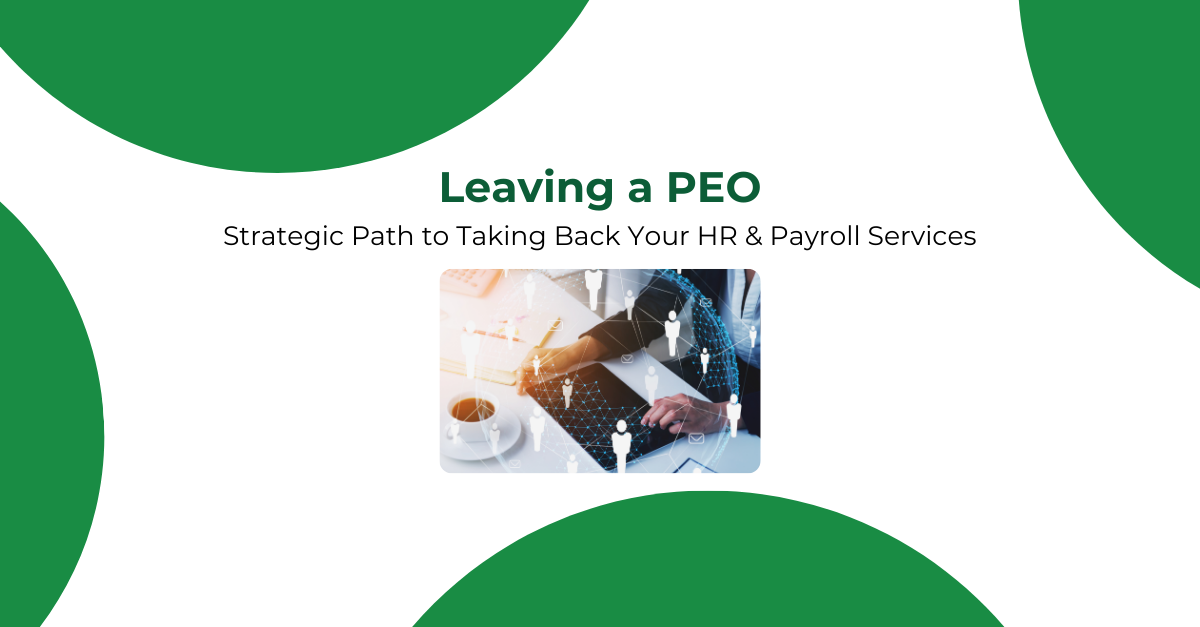For many startups and small businesses, partnering with a professional employer organization (PEO) can seem like a pretty smart move, especially in the early stages. A PEO takes the burden of payroll management, benefits administration, and HR compliance off your shoulders, giving you the room to focus on scaling the business. But what happens when your company starts to outgrow that relationship? Suddenly, you find yourself paying a hefty fee for something that feels limiting—like you’re stuck playing by someone else’s rules.
As someone who has spent years guiding businesses through HR transformations, I’ve seen this situation unfold time and time again. The truth is, while PEOs can offer convenience early on, they can also be costly, with fees that often outweigh the benefits. By taking HR and payroll services in-house, companies can reduce overhead, gain more control over processes, and tailor payroll and benefits to better suit their team’s needs—without the blanket policies or one-size-fits-all approach PEOs tend to impose.
So why not take back control?
If your company is hitting this point, it might be time to start thinking about offboarding from the PEO and running your own HR show in-house. Sure, the process can sound intimidating at first, but it doesn’t have to be. By getting familiar with the timeline and planning ahead, you’ll be able to steer clear of the common headaches and reclaim the reins.
Leaving a PEO: A Six-Month Timeline for Breaking Away
Typically, leaving a PEO is divided into two major phases: pre-Go Live and post-Go Live. The whole process? About six months, give or take. The first three months are spent untangling yourself from the PEO, and the next three months are all about making sure your new systems are up and running smoothly.
Pre-Go Live: Laying the Groundwork
The pre-Go Live phase is where the heavy lifting happens. You’ll need to set up payroll management, implement a benefits administration package, decide how HR responsibilities will be managed in-house, and replace any extra services you were getting from the PEO—like corporate insurance. Here’s the trick: get as much information as you can from your PEO before cutting ties. The more data you extract, the smoother your transition will be.
And here’s a key piece of advice from me: bring in an experienced project manager to guide the process. Don’t try to juggle this alongside your regular workload. A project manager will ensure everything stays on track while you stay focused on running and growing your business.
Post-Go Live: Making the Transition Seamless
Once your new HR and payroll services are in place and your PEO contract is officially over, it’s time to Go Live. This phase is all about keeping a close eye on your new systems. Is payroll processing without a hitch? Are the benefits packages delivering what employees expect? Are employees satisfied with the changes? It’s your moment to evaluate and adjust as needed.
Here’s the bottom line: with the right preparation, leaving a PEO doesn’t have to be a nightmare. You can regain control, cut down on costs, and improve your operations without breaking a sweat.

Fractional HR Services: The Game-Changer You Didn’t Know You Needed to Transition from your PEO
Here’s where fractional HR services come into play. Why not take advantage of expert HR support on a part-time basis? Fractional HR is the perfect solution for businesses transitioning away from a PEO. You get access to experienced professionals who handle everything from payroll management to employee relations—without the overhead of a full-time HR department.
At 512Financial, we’ve helped countless businesses make this transition smoothly. Our HR and payroll services are designed to guide companies through this process, offering seamless, stress-free offboarding.
A Real-Life Example: Smooth Sailing After PEO
Here’s an example of one company that successfully made the switch:
Jelena Radovanović, CHRL, Director of People Experience at Texada Software, shared her experience:
“Melissa has been an exceptional partner to our company over the past year. As a third-party expert, she led our successful transition from a PEO to in-house payroll, benefits, and 401k management. Early on, Melissa identified and resolved major issues we faced with our PEO following an acquisition, particularly in the areas of benefits and payroll. Her dedication and expertise single-handedly fixed these problems, paving the way for our move away from the PEO.
Melissa’s leadership throughout this process was invaluable. She managed the transition seamlessly, including registering us for payroll taxes in over 12 states. Her efforts ensured that we were fully prepared to manage our payroll and benefits in-house. Melissa’s commitment, knowledge, and proactive approach have made a significant impact on our organization. She has been an amazing partner, and we are grateful for her outstanding support and guidance.”
Strengthening Your People Strategy
Getting payroll and compliance in order is just the start. True HR strategy goes deeper—it’s about understanding your people and building a plan that helps them thrive. That’s why 512Financial offers people evaluations as part of our fractional HR services. These evaluations dig into your workforce’s strengths, uncover areas for growth, and help you build a team that’s aligned with your company’s goals—strengthening employee relations in the process.
Planning for Long-Term Success
Strategic human resource planning is more than just solving today’s problems. It’s about preparing for the future. At 512Financial, we help businesses develop proactive HR strategies that align with business objectives and ensure long-term success.
Why 512Financial?
Here’s the thing—we get it. Leaving a PEO is a big decision. But at 512Financial, we’ve got the experience and the know-how to make it easier. Our fractional HR and payroll services are tailored to fit your unique needs, from strategic planning to compliance management.
Let us help you take back control of your HR services and set your business up for future growth. Contact 512Financial today to learn how we can support your HR transition and ongoing needs.
Check out our most recent PEO transition case study and learn how we can help you through a real example.

